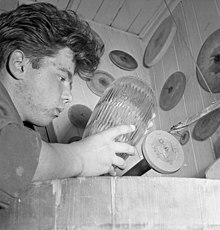Glass grinding
The glass-cutting (or glass grinding ) is a craft in which glass with engravings is decorated.
History of glass cutting
Glass objects found during excavations sometimes show traces of ground-in rings. These arise when you clamp a workpiece on a lathe-like device or glue it to a turntable and center it with wood. These first horizontal grinding benches existed as early as the 7th century BC. Chr. The work still had to be done by two people. While one is machining the workpiece with a tool, the other is turning the crank . The first pieces of glass were made in Mesopotamia . From there this craftsmanship spread across the Mediterranean . Around the birth of Christ , the glassmaker's pipe was invented, which streamlined work.
The bronze or copper wheel on the grinding bench is covered with an oil and quartz sand mixture . This hard mass then cuts into stones or glass and enables engraving . The craftsman holds the workpiece roughly sketched out with the design against the rotating disk .
For the ornamental cut, grinding wheels are used which are much smaller than for the shaping ones. Zinc white was still used as a grinding and polishing powder at the end of the 19th century . The glass could be worked on the lathe if the drills etc. were moistened beforehand with turpentine oil or with dilute sulfuric acid .
The sandblasting blower is also used to grind the glass , by driving sand against the glass with a powerful stream of air. A completely matt surface is achieved within a very short time. Using stencils made of soft, elastic material, you can create delicate, shaded patterns on flashed glass.
Glass grinder

The glass grinder makes engravings in glass and grinds decorations in glasses. In contrast to the Middle Ages, when the glass grinder was still considered an independent profession, the job description of the glazier partly includes the activity of glass finishing and glass design.
Glass refiners and glass engravers , as an independent professional group, design hollow and flat glass into transparent works of art. Both manual skills and a sense of color and knowledge of glass style are required.
Technical terms
- Cut edges are unprocessed glass edges that are created when the glass is cut. The edges of the cut edge are sharp.
- Hemmed edges : The hemmed edges correspond to the dimensions of the cut edge. The edges are broken with a whetstone .
- Ground edges , including finely adjusted edges, describe an edge surface that has been completely processed by grinding. These edges have a matte appearance.
- Polished edges are polished edges refined by overpolishing .
- Ornamental cuts are a further refinement of the edge surface
- Surface grinding is a grinding method similar to that on hollow glasses. Use on flat glass. Matting the surface also known as Mourey matting . Most elaborate method of matting a surface as only approx. 200 × 5 mm can be matted on the glass surface in one operation. Grinding approaches, lines and steps on the grinding wheels create a desired pattern that gives the surface a fine structure and shimmer in the incident light.
literature
- Emil Rimpler, Friedrich Holl: Glass refining craft in the field of tension between the past and the present. State guild of the glass finishing trade in Bavaria, Regen 1979.
- Terence Maloney: Glass. Research into and use of the transparent material (= the book on the matter ). German publishing house, Stuttgart 1970.
- Josef Ebert: The work of the glass grinder and etcher. Special print by Glaswelt , Gentner Verlag, Stuttgart.
swell
- ↑ glass . In: Meyers Konversations-Lexikon . 4th edition. Volume 7, Verlag des Bibliographisches Institut, Leipzig / Vienna 1885–1892, p. 390.

